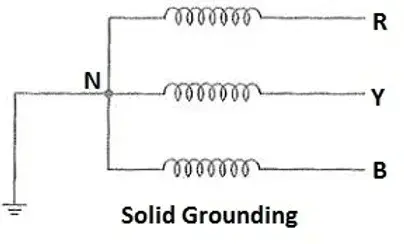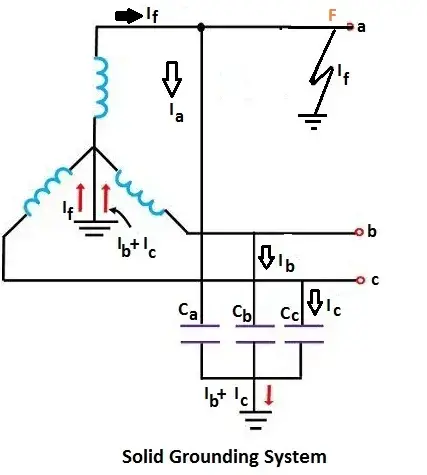When the live point of the electrical power supply system, which is at zero potential under normal condition, is connected to earth point is called grounding. The grounding can be done through resistance, reactance and solid grounding. Each grounding methods has its pros and cons.
Definition
When the neutral point of three phase system is connected to earth through a negligible resistance is called solid grounding or effective grounding. The Y (star) point of transformer , neutral point of star wound generator are effectively grounded or solidly grounded.

In solid grounding, the neutral potential is at zero potential under normal condition, and under faulty condition, the neutral voltage rises up to phase voltage. The voltage of the healthy phases do not increase when there is fault in system if the electrical system has perfect solid grounding.
In solid grounding, the fault current flow through a least resistance path because neutral point is clamped to the ground which has very low resistance, therefore it is desired that system impedance must be large enough to limit the fault current. The solid grounding is preferred when the circuit impedance is sufficiently large so as to limit the fault current. The solid grounding system is preferred when;
- The positive sequence impedance of the supply system is equal to or greater than the zero sequence impedance.
- The positive sequence reactance is three times greater or equal to the zero sequence reactance.

Consider three phase supply system with its neutral is connected to ground. If phase to ground fault occurs in a phase a, its phase voltage becomes zero. However, two healthy phase b and c has the same voltage as before and, these healthy phases continue to supply the fault current.
The ground fault current should not exceed 80 % of three-phase fault. The voltage of healthy phases does not rise in the solid grounding system. The fault current If is inductive in nature and the sum of currents (Ib+Ic )is capacitive. Thus, the capacitive current gets nullify with the inductive current and because of this no arcing voltage and overvoltage condition occurs.
In solid grounding system, the fault current is limited by the system impedance. Therefore, the solid grounding is used for voltage below or up to 33 kV with total power capacity not exceeding 5 MVA.
Advantages of the Solid Grounding
- The neutral is held at the zero potential.
- The voltage of healthy phase under fault in any of phases remains constant and thus no arcing voltage and over-voltage conditions occur.
- Heavy current flowing through earth can be easily sensed by the current transformer and faulty section can be isolated quickly by circuit breaker or fuses.
- Solid grounding reduce the possibility of over voltages.
- Voltage of the healthy phases remains same as before the fault and thus, less insulation is required for equipment and it results into saving in the cost of equipment.
- It is easy to locate the point of fault.
- The solid grounding system allow to use phase voltage for single phase loads because phase to neutral voltage is about 58.7% of line to line voltage.
Disadvantages of the Solid Grounding
- The heavy earth fault current flows in the case of solidly grounded system and thus the system goes under heavy electrical and mechanical stress. It may even cause equipment damage if fault current is not interrupted by circuit breaker in time.
- The heavy earth fault current is cleared by a circuit breaker and this may cause damage of breaker contacts in a long run. The breaker must be of heavy duty for solid grounding system.
- The heavy fault current can create interference in the neighboring communication circuit.
- The ground fault current is limited by system impedance only and thus the ground fault current magnitude is very high. This high current can cause an arc flash at the point of fault and can cause severe damage.
- The voltage at the point of fault can exceed 100 volts when a high fault current flow through from the point of fault to the ground. The magnitude of the voltage at fault is equal to the product of the fault current and the ground impedance.